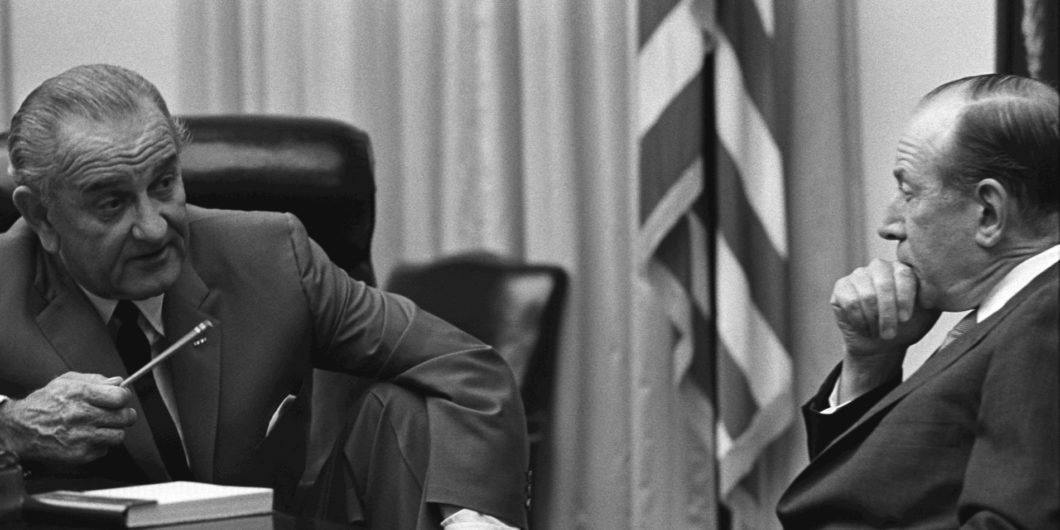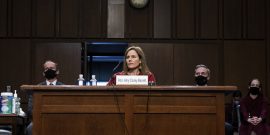Origins of the Politicized Confirmation
Robert Bork, in his book, The Tempting of America (1989), noted that it was a perverse method of civic engagement in a constitutional republic to have demonstrators outside of the Supreme Court. Bork rightly viewed such seemingly innocuous demonstrations as the pathological behavior that results from the politicization of the courts. The Court has become, as the late legal historian David O’Brien termed it, the “storm center” of much of American politics. Bork believed this storm was created by the Supreme Court itself, in consciously choosing to become a political institution. It arguably started during the New Deal, but definitely took its modern form with the Warren Court (1953-1969). Legal scholars have developed a rich debate about whether the courts are really leaders in social and political change or merely notable followers. Either way, the courts don’t want for trying.
In his Battle for the Marble Palace, author and lawyer Michael Bobelian has written a history of one chapter in the politicization of the Supreme Court during the Warren Court Era. Bobelian’s subject is the nomination of Abe Fortas to the chief justiceship of the Court in 1968. Using extensive research in archives, some first-hand interviews, and a wealth of secondary sources, Bobelian has provided an account of the formal and informal (i.e., backroom) proceedings in the nomination and, more broadly, a history of the early days of the modern judicial politics with which we are so familiar today.
Bobelian contends that he came to his subject because he had been wrongly convinced that the nomination of Bork in 1987 was the beginning of highly politicized Court nominations, when in reality the Fortas nomination was the true starting point.
It would be more accurate to qualify this claim by specifying that the Fortas nomination was the beginning of the modern confirmation process, with made-for-TV moments and the grilling of the nominee, which current Associate Justice Elena Kagan says has become a “vapid and hollow charade.” But political controversy over Supreme Court nominations has been with us from the earliest days of the Republic. For example, John Rutledge became the second chief justice through a recess appointment in 1795. Shortly thereafter, Rutledge gave a speech criticizing the Jay Treaty, which angered Federalists in the Administration and Congress. Federalists claimed Rutledge was mentally ill and an alcoholic prior to his Senate confirmation vote, which resulted in his rejection by a vote of 14-10. Rutledge resigned two days later and less than two weeks later failed in a suicide attempt. As the Court became more important in American life, some nominations took on greater political notoriety, such as Louis Brandeis’ nomination in 1916 and Felix Frankfurter’s in 1938.
Rise and Fall of Abe Fortas
Although Fortas’ nomination is not the earliest example of political controversy, it is a strikingly familiar tale. A controversial nominee is pilloried in the press, faces scandalous accusations before and during the Senate confirmation hearing, and is ultimately rejected in a partisan battle reflecting society’s vicious political divisions.
Abe Fortas had a meteoric rise as a first-generation American from Memphis to become one of the leading insider lawyers in Washington, D.C., from the era of the New Deal to the Great Society. Fortas had been one of the youngest students admitted to Yale Law School, and shortly after graduation, he was invited to be a professor at Yale. He left academia to work at the Securities and Exchange Commission and Interior Department during the New Deal and later co-founded what would become (and remain today) one of the largest law firms in America, Arnold and Porter. He went on to become a notable advocate before the Supreme Court and finally an advisor to LBJ.
It was Fortas’ close friendship with Lyndon Johnson that resulted in his appointment to the Court in 1965 as an Associate Justice. Bobelian’s delving into the LBJ Oral History Project’s papers reveals that Fortas was apparently resistant to his nomination to the Court in 1965, and LBJ apparently nominated him, after a typical browbeating session, without Fortas’ consent. Yet, Fortas’ nomination as an associate justice was uncontroversial. As Bobelian notes, in 1965 Fortas was confirmed within two weeks of his nomination, with just under three hours of Senate Judiciary testimony, no background check by the Justice Department or Senate, and on a voice vote. His nomination to chief justice three years later would be very different.
What happened in just three years? In short, the Court became an increasingly politicized institution. The Warren Court’s tenure is an oft-told and well-known story, and Bobelian does not waste space in recounting this history. Instead, he reviews the personalities behind the positions for and against Fortas’ elevation in 1968. Among the key players were Everett Dirksen (the Illinois Republican Senate Minority Leader, who was an ally of LBJ in this instance), Earl Warren (the then-chief justice who supported Fortas’ elevation and who was criticized for attempting to engineer his successor), Strom Thurmond (the South Carolina senator and infamous segregationist who became a ringleader against Fortas), and the little known (then and now) Robert Griffin (a first-term senator in 1968 and an unlikely candidate to become the leader of the opposition to Fortas’ nomination).
Bobelian’s account reveals just how bipartisan and personal legislative politics was in the 1960s. For example, Everett Dirksen, although not an ideologue, was firmly against the reapportionment cases of the early 1960s, which resulted in the famous one-person, one-vote rule. Dirksen had been a floor leader on an effort to enact a constitutional amendment and later a convention to overturn the reapportionment rulings. He also led an effort for an amendment to reverse the Court’s decision banning public school prayer. Yet Dirksen was also a friend and former colleague in the Senate of LBJ. Dirksen had helped break the filibuster against the 1964 Civil Rights Act and, after a White House meeting with LBJ, he agreed to support Fortas’ elevation. However, it was not merely friendship that motivated Dirksen. He made his own demands: Dirksen feared running for re-election against Adlai Stevenson’s son, Adlai Stevenson III, and LBJ assured him that he would contact Chicago Mayor Richard Daley. In fact, Illinois Attorney General William Clark ran against Dirksen and lost. Dirksen left the White House assuring Johnson that, although the Senate Republicans would put up a “little ruckus,” Fortas would “be confirmed, period.”
The ideological fervor of Fortas’ opponents demonstrates that the modern, extremely partisan process of High Court nominations began in 1968.
Bobelian’s account shows that Fortas’s nomination was a turning point. Recent nominations had been confirmed quickly, after a short, pro forma Judiciary Committee hearing and usually—as with Fortas’ first nomination—by voice vote. Yet moderate Robert Griffin and segregationist Strom Thurmond would unite factions of the Republican and Democratic parties against this nomination, resulting in a successful filibuster.
Griffin was a first-term Republican senator from Michigan in 1968. Shortly after the Fortas elevation was announced, Griffin became a vocal opponent. The account of Griffin’s unlikely role is one minor weakness in Bobelian’s account, as the author does not provide a comprehensive explanation for Griffin’s opposition. It seems that Griffin was an example of a moderate who thought the Court had gone too far in its activism. He claimed Fortas was a Johnson crony and, since LBJ was a “lame duck,” the next president should make the nomination after “the people” had voted. Bobelian’s contention that Griffin was motivated by ambition may explain some of Griffin’s actions. But it was also likely that he was being ideological: Griffin feared LBJ’s nominee would perpetuate the Warren-era liberalism.
Perhaps the most important opponent—and certainly the most visible—was Strom Thurmond. Thurmond had been in the Senate since the mid-1950s and was a consummate political survivor, willing to adapt to the prevailing political winds of his state. But Thurmond genuinely believed the Warren Court was a danger to the rule of law and to public morals: He published a general critique of the Court only a few months before Fortas’ confirmation hearings noting that “The Supreme Court has changed law from something absolute to something relative.” The Court’s civil libertarian tendencies earned most of his ire: “our children,” he claimed, “are being deprived of the moral foundations they need to become good citizens.” Thurmond’s vocal opposition made the confirmation hearings into a circus-like affair, with Thurmond making much of Fortas’ votes on the court to overturn obscenity convictions. He even held screenings of pornographic films in the Senate hearing rooms, jokingly dubbed the Fortas Film Festival.
The confirmation hearings lasted 11 days spread over two months. By October 1968, the nomination died when the filibuster was successful. Although Republicans and conservative Democrats had opposed him on ideological grounds, Fortas gave his opponents plenty of other ammunition. It was revealed, for instance, that Fortas had taught an adjunct course for $15,000 (whereas the usual fee would have been $2,000). In the hearings, Fortas claimed he was “seldom” a visitor to the White House after he became an associate justice but it was later revealed that he had visited the White House over 80 times after ascending to the Court. After his nomination failed, many urged Fortas to resign his associate justice post when it was revealed that he had taken a $20,000 retainer from friend and financier Louis Wolfson while on the Court.
Origin of Our Confirmation Wars
Bobelian’s account provides strong evidence that the Fortas nomination was the starting point for politicized nominations to the postwar Supreme Court. Certainly legislators’ careerism and partisan ambitions played a role, but the ideological fervor of Fortas’ various opponents demonstrates that the modern, extremely partisan process began in 1968.
Although Bobelian does not stress this point, it is notable that the Court itself invited such a response. Earl Warren’s strategic retirement was an invitation to LBJ to make an additional long-term mark upon the Court, and the Court’s jurisprudence in the 1960s had made it an unambiguously political branch. The Warren Court intentionally made constitutional law a political affair by way of invented rights, a continuation of the New Deal Court’s blanket approval of economic regulations under an expansive interpretation of the Commerce Clause, and an extreme libertarian approach to an array of civil liberties and criminal procedure issues. It should have surprised no one that a foot soldier in that effort, Abe Fortas, would become a target when opponents of the Warren Court were given a chance. Bobelian’s denouement affirms this point, with the attention he gives to Richard Nixon’s failed nominations of Clement Haynsworth and Harrold Carswell, both of which were intensely resisted by Democrats. Nominations subsequent to Carswell’s, which Bobelian does not cover, were somewhat less contentious until the nomination of Bork in 1987.
Although Fortas had a sterling pedigree, he was no model for a justice. It was fortuitous that his elevation to chief justice failed. Michael Bobelian has done yeoman’s work in using primary and secondary sources to reveal the varied motives and diverse actors involved in this important step in the transformation of judicial appointments into vicious political contests.


